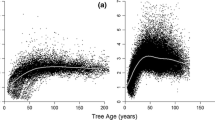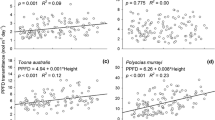Abstract
Trees outside closed forest stands differ in the relation between stem diameter, height and crown volume from trees that grew with neighbours close by. Whether this plasticity in tree shape varies between species in relation to their light requirement is unknown. We purposefully sampled 528 trees ranging 5–100 cm diameter at breast height growing in a range of light conditions. Across ten broad-leaved species observed in Sumatra or Kalimantan, a generic relationship was found between light exposure of the crown and a light-dependent a l parameter that modifies the height–diameter allometric equation (H = a l D b) from those for closed stands. In our results, vertical stretching is well predicted by light availability. In fully open conditions, trees are on average 31% shorter for the same diameter than under (partial) shade. Most of the stretching response occurs in all species as soon as some degree of lateral shading occurs. The response, however, varies by species (8–44% reduction) in a way apparently unrelated to species’ successional status. Crown volume varied less than stem height in its relationship with stem diameter across all light conditions tested. The scaling of crown volume with stem diameter, however, differed markedly between tree species.



Similar content being viewed by others
References
Aasamaa K, Sõber A (2001) Hydraulic conductance and stomatal sensitivity to changes of leaf water status in six deciduous tree species. Biol Plant 44:65–73
Aiba M, Nakashizuka T (2009) Architectural differences associated with adult stature and wood density in 30 temperate tree species. Funct Ecol 23:265–273
Akaike H (1974) A new look at the statistical model identification. IEEE Trans Autom Control 19:716–723
Alder D, Synnott TJ (1992) Permanent sample plot techniques for mixed tropical forest, vol 25. Oxford Forestry Institute, Department of Plant Science, Oxford, pp 81–83
Ballaré CL (1999) Keeping up with the neighbours: phytochrome sensing and other signalling mechanisms. Trends Plant Sci 4:97–102
Beauchamp JJ, Olson JS (1973) Corrections for bias in regression estimates after logarithmic transformation. Ecology 54:1403–1407
Bohlman S, O’Brien S (2006) Allometry, adult stature and regeneration requirement of 65 tree species on Barro Colorado Island, Panama. J Trop Ecol 22:123–136
Brüchert F, Gardiner B (2006) The effect of wind exposure on the tree aerial architecture and biomechanics of Sitka spruce (Picea sitchensis, Pinaceae). Am J Bot 93:1512–1521
Burnham KP, Anderson DR (2002) Model selection and multimodel inference. A practical information-theoretic approach. Springer, New York
Burns RM, Honkala BH (eds) (1990) Silvics of North America. USDA Forest Service, Washington, DC
Cabanettes A, Auclair D, Imam W, Dupraz C (1998) Diameter and height growth curves for widely-spaced trees in European agroforestry. Agrofor Syst 43:169–181
Canham CD, LePage PT, Coates KD (2004) A neighborhood analysis of canopy tree competition: effects of shading versus crowding. Can J For Res 34:778–787
Collinet F (1997) Essai de regroupements des principales espèces structurantes d’une forêt dense humide d’après l’analyse de leur répartition spatiale (Forêt de Paracou-Guyane) In: vol. PhD. Université de Lyon 1, Lyon, p 313
Dawkins HC (1963) Crown diameters: their relation to bole diameter in tropical forest trees. Commonw For Rev 42:318–333
Dawkins HC (1966) The productivity of tropical high-forest trees and their reaction to controllable environment. Commonwealth Forestry Institute, Oxford
Enquist BJ, Niklas KJ (2002) Global allocation rules for patterns of biomass partitioning. Science 295:1517–1519
Geoff Wang G (1998) Is height of dominant trees at a reference diameter an adequate measure of site quality? For Ecol Manag 112:49–54
Gilbert IR, Jarvis PG, Smith H (2001) Proximity signal and shade avoidance differences between early and late successional trees. Nature 411:792–795
Hairiah K, Dewi S, Agus F, Velarde SJ, Ekadinata A, Rahayu S, van Noordwijk M (2011) Measuring carbon stocks across land use systems: a manual. World Agroforestry Centre (ICRAF) Southeast Asia Regional Program. Bogor, Indonesia
Hastie TJ, Tibshirani RJ (1990) Generalized additive models. Chapman & Hall, New York
Heineman KD, Jensen E, Shapland A, Bogenrief B, Tan S, Rebarber R, Russo SE (2011) The effects of belowground resources on aboveground allometric growth in Bornean tree species. For Ecol Manag 261(11):1820–1832
Hemery GE, Savill PS, Pryor SN (2005) Applications of the crown diameter–stem diameter relationship for different species of broadleaved trees. For Ecol Manag 215:285–294
Henry HAL, Aarssen LW (1999) The interpretation of stem diameter-height allometry in trees: biomechanical constraints, neighbour effects, or biased regressions? Ecol Lett 2:89–97
Ilomaki S, Nikinmaa E, Makela A (2003) Crown rise due to competition drives biomass allocation in silver birch. Can J For Res Revue Canadienne De Recherche Forestiere 33:2395–2404
Jack SB, Long JN (1991) Analysis of stand density effects on canopy structure: a conceptual approach. Trees Struct Funct 5:44–49
Jøker D (2000) Alstonia scholaris (L.) R.Br. In: Seed leaflet, vol 9. Danida Forest Seed Centre, Denmark
King DA, Davies SJ, Supardi MNN, Tan S (2005) Tree growth is related to light interception and wood density in two mixed dipterocarp forests of Malaysia. Funct Ecol 19:445–453. http://onlinelibrary.wiley.com/doi/10.1111/j.1365-2435.2005.00982.x/full
Kohyama T (1994) Size-structure-based models of forest dynamics to interpret population- and community-level mechanisms. J Plant Res 107:107–116
Lawrence D, Suma V, Mogea JP (2005) Change in species composition with repeated shifting cultivation: limited role of soil nutrients. Ecol Appl 15:1952–1967
LeGoff N, Ottorini JM (1996) Leaf development and stem growth of ash (Fraxinus excelsior) as affected by tree competitive status. J Appl Ecol 33:793–802
Loehle C (1997) The adaptive significance of trunk inclination on slopes: a commentary. Proc R Soc Lond Ser B Biol Sci 264:1371–1374
Makela A, Valentine HT (2006) Crown ratio influences allometric scaling in trees. Ecology 87:2967–2972
Muller-Landau HC et al (2006) Testing metabolic ecology theory for allometric scaling of tree size, growth and mortality in tropical forests. Ecol Lett 9:575–588
Naidu SL, DeLucia EH, Thomas RB (1998) Contrasting patterns of biomass allocation in dominant and suppressed loblolly pine. Can J For Res 28:1116–1124
Niklas KJ (1994) Plant allometry: the scaling of form and process. University of Chicago Press, Chicago
Niklas KJ (1995) Size-dependent allometry of tree height, diameter and trunk-taper. Ann Bot 75:217–227
Osunkoya OO, Omar-Ali K, Amit N, Dayan J, Daud DS, Sheng TK (2007) Comparative height crown allometry and mechanical design in 22 tree species of Kuala Belalong rainforest, Brunei, Borneo. Am J Bot 94:1951–1962
Pryor SN (1988) The silviculture and yield of wild cherry. Forestry Commission Bulletin, London
Robert A, Moravie MA (2003) Topographic variation and stand heterogeneity in a wet evergreen forest of India. J Trop Ecol 19 Part 6:697–707
Skovsgaard JP, Vanclay JK (2008) Forest site productivity: a review of the evolution of dendrometric concepts for even-aged stands. Forestry 81:13–31
Sprugel DG (1983) Correcting for bias in log-transformed allometric equations. Ecology 64:209–210
Vanclay JK, Henry N (1988) Assessing site productivity of indigenous cypress pine forest in southern Queensland. Commonw For Rev 67:53–64
Vincent G (2001) Leaf photosynthetic capacity and nitrogen content adjustment to canopy openness in tropical forest tree seedlings. J Trop Ecol 17:495–509
Vincent G (2006) Leaf life span plasticity in tropical seedlings grown under contrasting light regimes. Ann Bot 97:245–255
Vincent G, Harja D (2008) Exploring ecological significance of tree crown plasticity through three-dimensional modelling. Ann Bot 101:1221–1231
Vincent G, De Foresta H, Mulia R (2002) Predictors of tree growth in a Dipterocarp based agroforest: a critical assessment. For Ecol Manag 161:39–52
Vincent G, Azhima F, Joshi L, Healey JR (2011) Are permanent rubber agroforests an alternative to rotational rubber cultivation? An agro-ecological perspective. For Trees Livelihoods 20:85–109
Wang Y, Titus SJ, LeMay VM (1998) Relationships between tree slenderness coefficients and tree or stand characteristics for major species in boreal mixedwood forests. Can J For Res 28:1171–1183
Watt MS, Palmer DJ, Kimberley MO, Hock BK, Payn TW, Lowe DJ (2010) Development of models to predict Pinus radiata productivity throughout New Zealand. Can J For Res 40:488–499
Weiner J (1990) Asymmetric competition in plant populations. Tree 5:360–364
Weiner J (2004) Allocation, plasticity and allometry in plants. Perspect Plant Ecol Evol Syst 6:207–215
Weinland G (1998) Plantation. In: Turnbull SAJM (ed) A review of dipterocarps: taxonomy, ecology, and silviculture. CIFOR, Bogor, pp 151–186
Williams H, Messier C, Kneeshaw DD (1999) Effects of light availability and sapling size on stem growth and crown morphology of understory Douglas-fir and lodgepole pine. Can J For Res 29:222–231
Zeide B, Vanderschaaf C (2002) The effect of density on the height–diameter relationship. In: General Technical Report SRS-48. U.S. Department of Agriculture, Forest Service, Southern Research Station, Asheville, NC, pp 463–466
Author information
Authors and Affiliations
Corresponding author
Additional information
Communicated by R. Matyssek.
Rights and permissions
About this article
Cite this article
Harja, D., Vincent, G., Mulia, R. et al. Tree shape plasticity in relation to crown exposure. Trees 26, 1275–1285 (2012). https://doi.org/10.1007/s00468-012-0703-x
Received:
Revised:
Accepted:
Published:
Issue Date:
DOI: https://doi.org/10.1007/s00468-012-0703-x




